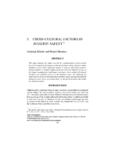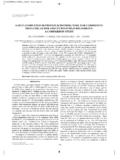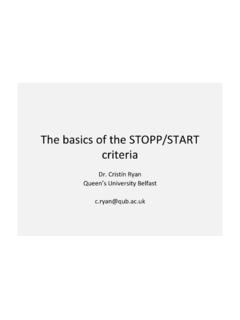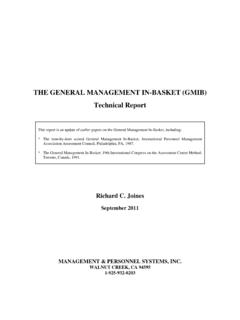Transcription of Behavioral Markers for Crew Resource …
1 Behavioral Markers forCrew Resource Management:A review of Current PracticeRhona FlinDepartment of PsychologyUniversity of AberdeenKing s CollegeAberdeen, ScotlandLynne MartinNASA Ames Research CenterMoffett Field, CADevelopments in crew Resource management (CRM) have progressed from the in-troduction of training programs to the evaluation of CRM skills, particularly formulticrew cockpits. European regulators responsible for flight operations and flightcrew licensing (Joint Aviation Authorities, 1996, 1997) are introducing require-ments for the training and assessment of pilots nontechnical skills. This article re-ports a review of the literature and a survey of current practice in the developmentand use of Behavioral marker systems for training and assessing nontechnical CRMskills in international and domestic (UK) airlines.
2 In general, there appears to be awide range of practice in the design and implementation of Behavioral Markers sys-tems within CRM programs. Emerging issues relating to content validity of markersystems and rater reliability are likely to become the focus of both researchers andpilots efforts to assess the value and impact of crew Resource management (CRM)have consisted of standard training evaluation techniques based on pilots opinionsof the quality and relevance of the programs, in the United States (Gregorich & Wil-THE INTERNATIONAL JOURNAL OF AVIATION PSYCHOLOGY,11(1), 95 118 Copyright 2001, Lawrence Erlbaum Associates, for reprints should be sent to Rhona Flin, Department of Psychology, University ofAberdeen, King s College, Old Aberdeen AB24 2UB, Scotland.)
3 E-mail: 1993) and in Europe (Maschke, Goeters, Hormann, & Schiewe, 1995; Naef,1995). Additional research has indicated that pilots attitudes toward accident re-lated behaviors were improved by CRM training (see Helmreich, Merritt, & Wil-helm, 1999). These are important measures, but they are not a robust test of the ef-fectiveness of CRM, which was introduced with the aim of improving flight safetyand minimizing accident rates. The required proof that aviation accidents havebeen reduced as a result of CRM remains elusive (but, see Diehl, 1991), as inci-dence rates are very low, making any trends directly attributable to CRM difficultto detect (Helmreich et al., 1999). To assess whether CRM training is transferringto the flight deck, evaluation efforts are now targeted to observe the practice ofCRM skills (Holt, Boehm-Davis, & Beaubien, in press; Salas, Fowlkes, Stout,Milanovich, & Prince, 1999) and the development of reliable, valid measures forassessing a crew s or a pilot s nontechnical of this drive for CRM assessment has come from the advanced qualifica-tion program (AQP) adopted by several airlines.
4 These carriers undertake afull technical and nontechnical skills analysis, provide CRM and line orientedflight training (LOFT) for all flight crews, and undertake evaluation of CRM skillsusing line oriented evaluation (LOE) in full mission simulation (Birnbach &Longridge, 1993; Lanzano, Seamster, & Edens, 1997). They have developed corelists of CRM knowledge and skills ( , Boehm-Davis, Holt, & Seamster, inpress) and may include key CRM behaviors on their flight deck checklists ( ,Helmreich, 1996).In the UK, human factors training and examination are required for a flightcrew licence, and CRM training has been a mandatory requirement for commercialpilots since January, 1995.
5 There is no requirement to formally assess CRM skills,and any evaluation is currently done on a voluntary basis by the airlines, althoughsome guidance is available (Civil Aviation Authority [CAA], 1998). In Europe,Joint Aviation Requirements Flight Operations (JAR OPS) and Joint AviationRequirements Flight crew Licensing (JAR FCL) require CRM training and eval-uation of CRM skills in multicrew operations (Joint Aviation Authorities [JAA],1996, 1997; see Goeters, 1998). This indicates a need for a set of fundamentalCRM (nontechnical) skills and the relevant Markers to ensure an equitable system(CAA, 1998).The termbehavioral markersrefers to a prescribed set of behaviors indicativeof some aspect of performance.
6 Typical behaviors are listed in relation to compo-nent skills and are now used for selection, training, and competence assessment inprofessions such as anesthesiology (Gaba et al., 1998). Although there is consider-able interest by the civil aviation community in the identification and assessmentof CRM skills, there is limited research literature on this topic. The aim of thisstudy was to examine current practice in the development and use of behavioralmarkers for training and assessing CRM skills. A literature review was under-taken, followed by surveys of airlines in the UK and AND MARTINLITERATURE REVIEWThe literature review concentrated on two main themes: the development of markersystems and the reliability and training of the raters using Systems: Research and DevelopmentThe seminal research on Behavioral Markers produced the Line/Los Checklist(LLC; Helmreich, Wilhelm, Kello, Taggart, & Butler, 1990), which is widely citedin the literature and is the basis of many airlines CRM Behavioral marker lists.
7 It isused during in-flight observations to evaluate nontechnical CRM skills in humanfactors line audits carried out for major airlines (Helmreich, Hines, & Wilhelm,1996; Taggart, 1995). The behaviors included on the LLC have their origin in theanalysis of accidents and incidents with identifiable human factors causation ( ,Connelly, 1997), as well as supporting evidence from psychological research. Ver-sion, (Helmreich, Butler, Taggart, & Wilhelm, 1997) elicits ratings forfour phases of flight, under six categories of behaviors: team management and crewcommunications, situational awareness and decision making, automation manage-ment, special situations, technical proficiency, and overall observations.
8 This givesa total of 28 Behavioral marker elements and two overall evaluation measures, all ofwhich are rated on a 4-point scale ranging from 1 (poor), 2 (minimum expectations),3(standard), to 4 (outstanding). It should be noted that the LLC is used to evaluatethe crew s performance, rather than that of an individual pilot in a crew setting.(There is a separate section of the form for comments on a particular flight crewmember.)Using an earlier version of the LLC, Helmreich, Wilhelm, Gregorich, andChidester (1990) found high degrees of variation in CRM performance ratings forcrews flying different types of aircraft within the same airline. Across two airlines,different behaviors were linked (through their ratings) to superior performance.
9 InAirline 1, inquiry, technical skills, advocacy, and decision making were correlatedwith ratings of above average performance, whereas for Airline 2, superior perfor-mance was associated with briefings and concern for the group. The researcherscould not establish from their data whether these differences were due to true orga-nizational differences or to different emphasis on particular aspects of the CRMcourses during (1991) used the LLC and compared four airlines through 108 ob-servations on overall technical efficiency and overall crew effectiveness. Hefound a wide range of performance, as well as significant differences betweenairlines. He also reported that during training to use the LLC, trainees evalua-tions of the same crew s performance could vary widely, leading to his conclu-sion that standardization across raters is vital before the validity of CRMassessment can be properly Markers FOR CRM97 Law and Wilhelm (1995) used the LLC4 to collect 1,495 instructor observa-tions from two airlines.
10 Some elements were rated across all phases of flight,whereas others were rated only during certain phases or were rarely rated. Theyfound specific crew behaviors were differentially related to crew effectiveness atvarying phases of the flight and suggested that data should be collected for eachphase of flight. Significant differences were found between the ratings from thetwo airlines on 19 of the elements and also between fleets within the same com-pany. They concluded that the LLC4 is sensitive enough to detect reliable team-work and performance differences between and within the LLC, several other marker systems for assessing flight crew perfor-mance have been developed. With the aim of designing a prototype expert systemfor CRM assessment, Seamster and Edens (1993) asked six instructors to sort 60 LOFT concepts by identifying their reasons for grouping them together.










